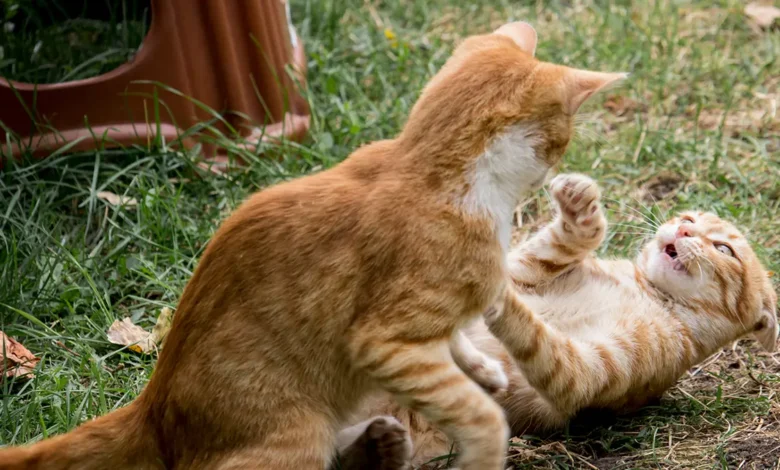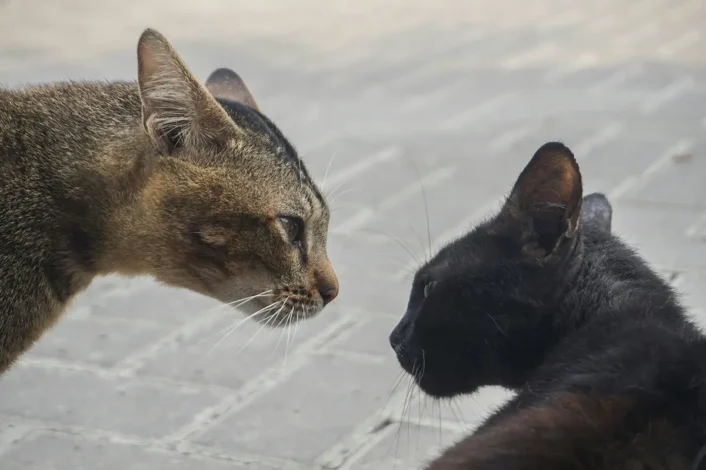
Statistics show that most cat lovers have at least two in their home. Most argue bringing the second cat into the house so that a cat is not alone and has a playmate. However, things can be a little different. Fights between cats living together are not uncommon and are very stressful for the owners. With a good understanding of the factors that trigger feline aggression, conflicts between cats in the home can be prevented or mitigated.
In general, stopping a conflict and aggression starts with identifying the causes and solving them.
Subject
Why do conflicts occur between cats in the house?
Aggression between cats living together in the same house is not an unusual behavior and can manifest itself in many ways. Aggression can be triggered by a variety of factors, from lack of socialization and competition for food to medical conditions or improper introduction of a new cat into the home. Even though they are domesticated, domestic cats have well-developed primal feline, predatory instincts that must defend their territory and food resources.
Conflicts between cats in the home can also be rooted in anxiety, fear, health issues that cause pain and stress, or even bringing a new cat into the home. Cats are also not without feelings of envy, possessiveness and jealousy. While it is normal for cats to have occasional conflicts, frequent aggression should be taken seriously. Cats are territorial animals, and any change in their environment can trigger intense reactions.
Before taking any action, it is important to consult a veterinarian to rule out medical causes or pain that could amplify the cat's aggressive behavior.
Bringing a new cat into the home
The integration of a new cat in the presence of existing ones must be done carefully, because the way this process is carried out will significantly influence their long-term relationship and it will be more difficult to avoid conflicts between cats in the house. Even if the cat you already have has lived with other felines before and has proven friendly, it can be tempting to let the new cat interact with her right away. However, this approach can create unwanted tensions.
You might assume they'll figure it out on their own, but cats don't always react well to situations like this. A negative initial meeting can lead to a strained relationship down the road. Therefore, the introduction of a new cat must be gradual, taking into account the personality and needs of each individual animal.
While it may be difficult to resist the temptation to let them interact quickly, such haste can lead to conflict. The cat you already have may perceive the newcomer's presence as a threat to its territory and food resources. She may become insecure, which can trigger behavioral changes or even aggression towards the new cat, neither of which help.
From the new cat's perspective, the environment is completely unknown. Scents, sounds and the presence of another cat can be perceived as threats, making her feel vulnerable and stressed. If the new cat was adopted from a more restricted environment, such as a shelter, the sudden adjustment to freedom can be overwhelming for her, causing even more discomfort.
Also read: Accommodating the cat in a new home - Useful Tips
To prevent conflicts between cats in the house, make a gradual introduction, initially separating the cats and allowing them to become familiar with new smells and sounds. Supervise interactions and make sure each cat has a safe haven.
Competition for food resources, water, places to relax
Conflicts between cats in the house very often arise due to the sharing of resources. Food, water, the litter box or even places to sleep and relax can be serious reasons for fighting between cats. If a cat feels that it does not have sufficient access to the necessary resources, it may become aggressive in the face of competition.

Make sure there are enough resources distributed in different locations of the house. Provide multiple litter boxes, resting areas, and play areas so that each cat has access to them without feeling threatened by the others. Also, try feeding the two conflicting cats separately for a period of time.
Lack of socialization can generate conflicts between cats in the house
Cats that have not been properly socialized during the critical period (between 2 and 7 weeks) may develop difficulties interacting with other animals. These cats have not learned to recognize and interpret the normal communication signals of other felines, which can lead to exaggerated reactions. Instead of avoiding conflict, they may respond aggressively or look for places to hide.
In this situation, the best solution is to gradually introduce positive interactions with other cats, using rewards and close supervision to minimize tensions. Try playing with the more sociable cat in the presence of the aggressive one. Eventually, the aggressive cat will return to better feelings and be tempted to be part of the game.
Medical problems can be the cause of aggression in cats
Cats suffering from pain or other medical problems can become more irritable and aggressive towards other cats in the house. Conditions such as osteoarthritis, hyperthyroidism or dental disease can exacerbate this behavior.
It is recommended to consult a veterinarian if you notice sudden changes in your cat's behavior. Proper treatment of medical conditions can significantly reduce episodes of aggression and conflict between cats in the home.
Common causes of conflict between cats
Medical problems
Pain or discomfort from a medical condition can make a cat more irritable and prone to aggression. If conflicts persist, consult a veterinarian to rule out any medical problems.
Limited resources
If the cats do not have enough food, water, litter boxes or play areas, fights over these resources may occur. Make sure each cat has its own food and water bowl, litter box and play areas. Also, for a period of time, feed the cats in separate rooms to avoid competition for food.
Social hierarchy
Cats, like many social animals, establish a group hierarchy. Changes in this hierarchy, such as the introduction of a new cat or a change in the behavior of one of them, can trigger conflicts. Spend time with each cat individually, giving them attention and affection.
Stress and environmental changes
Changes in the environment (moves, guests, redecorating), loud noises or even changes in the daily routine can stress cats and make them more aggressive. Use cat pheromone diffusers (eg. Feliway) to create a calm atmosphere in the house. Maintain a positive and patient attitude throughout the accommodation process.
Incompatible personalities
Some cats just don't like each other, no matter how hard you try. In this case, the happiest situation is for them to tolerate each other over time. Even if they will not end up playing and sleeping together, with the passage of time the conflicts between them will die down.
In such situations, the most important thing is to show patience and positivity. Punishment of cats that show signs of aggression is excluded. Punishments can aggravate the situation and create an atmosphere of fear. Also, keep in mind that each cat is an individual with a unique personality. What works for one pair of cats may not work for another.



